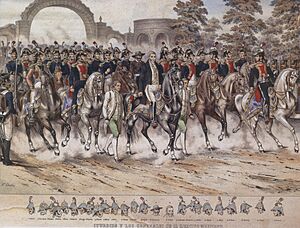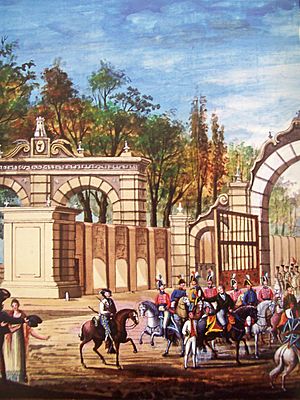Declaration of Independence (Mexico) facts for kids
Quick facts for kids Declaration of Independence of the Mexican Empire |
|
 Original copy of the Declaration
|
|
| Ratified | September 28, 1821 |
| Location | National Archives |
| Authors | Juan José Espinosa de los Monteros |
| Signers | 33 members of the board and Agustín de Iturbide |
| Purpose | To declare independence from Spanish Empire |
The Declaration of Independence of the Mexican Empire (Spanish: Acta de Independencia del Imperio Mexicano) was a very important paper. It was how Mexico officially said it was free from Spain. This happened on September 28, 1821, in Mexico City. Juan José Espinosa de los Monteros wrote it. He was the secretary for the Provisional Governmental Board.
Three copies of this declaration were made. One was lost in a fire in 1909. The other two copies are still around today. One is in the Fort of San Diego in Acapulco. The other is in the General Archive of the Nation in Mexico City. The document is about 53 centimeters (21 inches) wide and 72 centimeters (28 inches) tall.
Contents
How Mexico Became Independent

Mexico fought for its freedom from Spain for many years. This fight was called the Mexican War of Independence. On September 27, 1821, the war finally ended. The Army of the Three Guarantees, led by Agustín de Iturbide, marched into Mexico City.
The very next day, Iturbide set up a group called the Provisional Governing Board. This board had 38 people. Their main job was to create the Declaration of Independence.
A few weeks later, on October 13, 1821, the Declaration was shared with everyone. Ramón Gutiérrez del Mazo, a leader in Mexico City, made sure copies were sent out. He wanted all people, courts, and military leaders to read it. This way, everyone would know Mexico was now free.
Writing and Signing the Declaration
On the afternoon of September 28, 1821, the Provisional Governing Board met. They gathered at the National Palace in Mexico City. Their goal was to write the Declaration of Independence for the new nation.
Juan José Espinosa de los Monteros, the Board's secretary, wrote the final version. Two official copies were made. Thirty-three of the 38 board members signed the documents. Agustín de Iturbide also signed as the President of the Regency of the Empire.
Some important people did not sign. For example, Juan O'Donojú, who was the last Spanish leader in Mexico, did not sign. However, his name was written on the document. Some people like Guadalupe Victoria and Vicente Guerrero also did not sign. They were important leaders in the fight for independence. It is thought they might not have signed because they wanted Mexico to be a Republic, not an Empire.
What the Declaration Said
The Declaration of Independence of the Mexican Empire was a powerful statement. It said that the Mexican Nation had been under Spanish rule for 300 years. It declared that Mexico was now free from this control.
The document praised the "heroic efforts" of Mexico's people. It said their fight for freedom was a "memorable enterprise." The Declaration stated that Mexico now had all the rights given by nature. It was free to choose how it wanted to govern itself.
Mexico declared itself a "Sovereign nation." This meant it was fully independent from old Spain. The Declaration said Mexico would only have a close friendship with Spain from then on. It also said Mexico would make friends with other countries. The new government would follow the rules set in the Plan of Iguala and the Treaty of Córdoba. These were important agreements made during the fight for independence. The Declaration ended by saying this important statement was made on September 28, 1821. This day marked the "first of Mexican Independence."
Who Signed the Declaration
Here is a list of the people who signed the Declaration of Independence. Their names are written as they appeared on the original documents. Only 34 of the 38 members of the Provisional Governmental Board signed. This includes the space left for Juan O'Donojú's signature.
- Agustín de Iturbide
- Antonio Obispo de Puebla
- Lugar de la firma de O'Donojú
- Manuel de la Bárcena
- Matías de Monteagudo
- José Yáñez
- Licenciado Juan Francisco Azcárate
- Juan José Espinosa de los Monteros
- José María Fagoaga
- José Miguel Guridi y Alcocer
- El Marqués de Salvatierra
- El Conde de Casa de Heras y Soto
- Juan Bautista Lobo
- Francisco Manuel Sánchez de Tagle
- Antonio de Gama y Córdoba
- José Manuel Sartorio
- Manuel Velázquez de León
- Manuel Montes Argüelles
- Manuel de la Sota Riva
- El Marqués de San Juan de Rayas
- José Ignacio García Illueca
- José María de Bustamante
- José María de Cervantes y Velasco
- Juan Cervantes y Padilla
- José Manuel Velázquez de la Cadena
- Juan Horbegoso
- Nicolás Campero
- El Conde de Jala y de Regla
- José María Echevers y Valdivieso
- Manuel Martínez Mancilla
- Juan Bautista Raz y Guzmán
- José María Jáuregui
- José Rafael Suárez Pereda
- Anastasio Bustamante
- Isidro Ignacio de Icaza
- Juan José Espinosa de los Monteros – Vocal Srio
Members Who Did Not Sign
The Three Original Documents
Three original copies of the Declaration were made and signed. Each copy had its own journey through history.
The First Copy: The Provisional Governmental Board's Copy
One copy was given to the Provisional Governmental Board. This copy was later displayed in the Chamber of Deputies. Sadly, a fire destroyed the building in 1909, and this copy was lost.
The Second Copy: The Ruiz de Velasco Family's Copy
The Ruiz de Velasco family owned one of the original copies for 128 years. This document was passed down through their family. It came from Nicolás Bravo, an important figure in Mexican history. In 1987, Pedro Ruiz de Velasco de la Madrid gave this document as a gift to Mexico. It is now kept safely in the Museo Histórico de Acapulco Fuerte de San Diego in Acapulco.
The Third Copy: The Regency of the Empire's Copy
A third copy was given to the Regency of the Empire. This copy was kept at the National Palace. However, it was stolen in 1830. Lucas Alamán, who was the Foreign Minister, wrote about the theft. He said that an "unfaithful employee" sold it to a French traveler. Alamán tried to get the document back but could not, even though he offered a lot of money.
Years later, Emperor Maximilian I of Mexico somehow got this document. After Maximilian was executed, his confessor, Agustin Fischer, took the document out of Mexico.
Later, the document appeared in Spain in a library. It was then sold to a Mexican historian named Joaquín García Icazbalceta. He kept it safe, and it passed to his son.
In France, a man named Florencio Gavito Bustillo bought the Declaration for 10,000 Mexican pesos. He wanted to give it back to the Mexican government. Sadly, he died in 1958 before he could. In his will, he asked that the document be given to the president.
The Mexican government checked if the document was real. Experts confirmed its authenticity in 1961. On November 21, 1961, Florencio Gavito Jauregui, Gavito Bustillo's son, gave the Declaration to President Adolfo López Mateos.
The document was displayed for a while at Chapultepec Castle. Then, it was moved to the General Archive of the Nation. In 2008, work began to restore the document. It was shown again in 2010 for Mexico's 200th independence celebration. However, experts worried about exposing it too much.
Today, this precious document is kept safe in a special vault. It is protected between acid-free covers. Experts are working on a way to display it permanently in the future.
Gallery
|
|
See also
 In Spanish: Acta de Independencia del Imperio Mexicano para niños
In Spanish: Acta de Independencia del Imperio Mexicano para niños
- Act of Independence of Central America
- Solemn Act of the Declaration of Independence of Northern America







